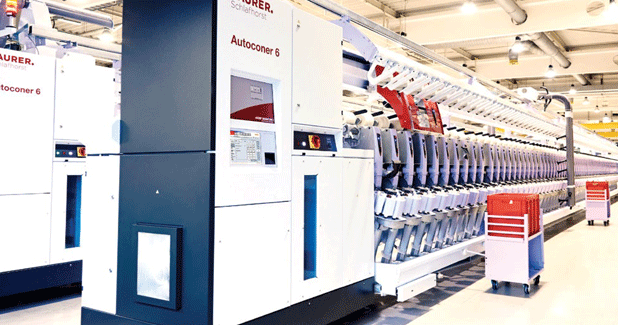
The new Autoconer 6: The best original ever
The Autoconer was the first automatic winding machine in history and each of its new machine generations caused quite a sensation in the textile industry. Now it is happening again: Equipped with improved process intelligence, the new Autoconer 6 boasts powerful innovations, a noticeable increase in productivity and best energy efficiency.
Now, with up to 80 winding units, the new Autoconer 6 type RM increases productivity per square metre by 9% in comparison to a machine with only 60 winding units.
The Autoconer was the first automatic winding machine in history and each of its new machine generations caused quite a sensation in the textile industry. Now it is happening again: Equipped with improved process intelligence, the new Autoconer 6 boasts powerful innovations, a noticeable increase in productivity and best energy efficiency. Thus Schlafhorst significantly raises the bar for high-yield efficiency in the winding process, especially since the basic model is already equipped with the key innovations. For Schlafhorst, the Autoconer 6 is quite simply the best original ever.
Intelligently controlled self-optimization is the major innovation topic of the sixth generation of the unsurpassed Autoconer. Automated process sequences are designed and structured to function in a self optimizing way. This ensures maximum productivity, resource efficiency, quality and process reliability in winding.
More intelligence for more productivity
The intelligent operation of the new Autoconer guarantees ultimate productivity at a consistent level. With a plus of 6 per cent, it sends a clear signal during start-up. Thus, the Autoconer 6 always starts with optimized acceleration without slippage, reaching its maximum winding speed faster than ever before. In addition, unproductive piecing cycle times are reduced to a minimum. The anti-patterning function is optimized for productivity.
The sophisticated material flow system ensures a 100 per cent capacity utilization of the winding units on the automated machines even in case of material flow variations.
The RM type has been completely redesigned. The new open design features a unique innovative bobbin change system that stores an additional bobbin in the new loading shaft and is thus ready for the change. 9+1 bobbins per winding unit is the success formula for a reliable, fast and therefore more productive bobbin change on RM machines. Now, with up to 80 winding units, the new Autoconer 6 type RM increases the productivity per square metre by 9 per cent in comparison to a machine with only 60 winding units.
Resource-saving technology
New highly efficient suction system motors, new intelligent control systems and aerodynamically improved components such as the new suction tube, reduce energy consumption and minimize yarn waste. With 6 per cent less resource consumption, the Autoconer 6 is off to a good start.
The new suction tube provides a significantly higher resource efficiency: fast, reliable upper yarn pick-up, reduced cycle frequency and duration, automatic, self-adjusting alignment of suction tube position. An intensification of upper yarn search is achieved together with the FlexiCycle. In the process, miscellaneous parameters such as the suction tube distance, intensity of the negative pressure as well as search time can be flexibly set. Upper yarn errors and red lights are a thing of the past.
The sensor-monitored negative pressure control of the Autoconer 6 creates only as much negative pressure as needed. The suction system automatically switches back and forth between requirement-oriented, increased working pressure for a reliable yarn end pick-up and the energy saving resting vacuum. All parameters are individually adjustable. Furthermore, compressed air can be reduced even more by setting the blowing impulses for cleaning of the winding units via the Multi-Jet on the Informator according to the actual level of soiling. The new waxing unit has an improved resource utilization, which cuts wax wastage by a third.
Automation and intelligent material flow
Due to its<




